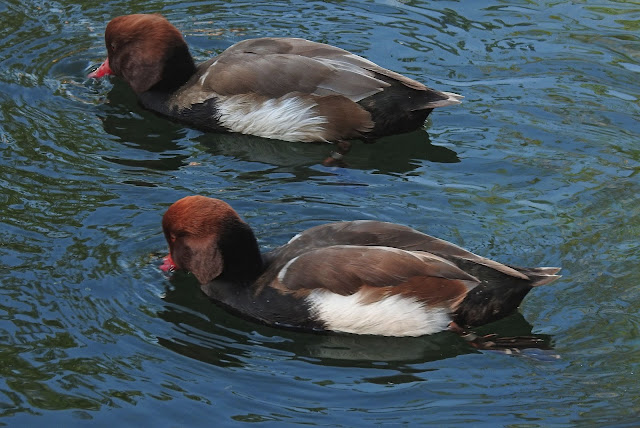The red-crested pochard (Netta rufina) is a large diving duck. The scientific name is derived from Greek Netta "duck", and Latin rufina, "golden-red" (from rufus, "ruddy"). Its breeding habitat is lowland marshes and lakes in southern Europe and it extends from the steppe and semi-desert areas on the Black Sea to Central Asia and Mongolia, wintering in the Indian Subcontinent and Africa. It is somewhat migratory, and northern birds winter further south into north Africa.
The adult male is unmistakable. It has a rounded orange head, red bill and black breast. The flanks are white, the back brown, and the tail black. The female is mainly a pale brown, with a darker back and crown and a whitish face. Eclipse males are like females but with red bills. They are gregarious birds, forming large flocks in winter, often mixed with other diving ducks, such as common pochards. They feed mainly by diving or dabbling. They eat aquatic plants, and typically upend for food more than most diving ducks.
A wheezing veht call can be given by the male. Series of hoarse vrah-vrah-vrah calls can also be heard from females.
Red-crested pochards build nests by the lakeside among vegetation and lay 8–12 pale green eggs. The birds' status in the British Isles is much confused because there have been many escapes and deliberate releases over the years, as well as natural visitors from the continent. However, it is most likely that they are escapees that are now breeding wild and have built up a successful feral population. They are most numerous around areas of England including Gloucestershire, Oxfordshire, Northamptonshire and also spotted in Leicestershire.
It is rare and more common in large lakes and reservoirs, especially those with reed beds. It is also found in urban parks as a domestic species. It usually feeds on the surface and by inserting its head under water. Striking and unmistakable male with a large, rounded, red head, long red beak and black breast. The female has a more uniform plumage color but stands out compared to other ducks: dirty buff in general with light cheeks, a dark face and a rounded, brown hood. In flight, both sexes have a wide wing band and whitish underwings.
Larger than a Pochard, the male has an orange-brown head with a red beak and pale flanks (lower sides). Females are brown with pale cheeks. In flight, they show whitish underwings. They dive, dabble and up-end for their food. There is a large population in Spain but smaller numbers in France, Netherlands and Germany. Occasional wild birds may come to the UK from the Continent. The UK breeding birds almost certainly all come from escaped birds.









%2010.jpg)
%2011.jpg)
%2012.jpg)






%2020.jpg)
%2021.jpg)
%2022.jpg)
%2020.jpg)
%2010.jpg)
%2011.jpg)
%2012.jpg)
%2014.jpg)



%2010.jpg)


%2010.jpg)



%2010.jpg)
%2011.jpg)